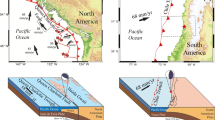Abstract
In order to determine how reliably one can invert accelerograms to determine the rupture process details, when the station configuration is less than optimal, we use the vertical component of synthetic accelerograms for a Haskell-type earthquake rupture model, at stations in the vicinity of a dip-slip fault and solve the inverse problem. Of the various station configurations used, one is a uniform distribution and the others are very non-uniform. Faults of two different aspect ratios are considered. We mainly use much larger spatial and temporal cell sizes in the inversion than we use to construct the artificial data. The fault mechanism and the fault area are taken as known in the inversions. To solve the inverse problem, we use the method of linear programming and stabilize the solution by the use of physical constraints. The constraints of positivity of the slip rates on the fault is used in all cases in this study. In some cases, additional physical constraints such as preassigning the final moment, the rupture speed, and so on, are also used. We find that using a cell size almost double the wavelength of interest, we are able to reproduce the solution of the problem, even when we add a small amount of random noise to the artificial data, provided the source medium structure is known. We show that the best station configuration is when the stations are on the hanging wall, due to the fact that they provide the best illumination of the fault surface. This provides an incentive to install permanent ocean bottom strong ground motion stations in subduction zones. We also analyzed the effect of the rupture propagation direction on the results of the inversion showing that even four stations are sufficient to retrieve the rupture process if they are in the forward direction of the rupture propagation; the results for this case are better than when the four stations are placed in the backward direction, even when their positions are such that they illuminate the fault in exactly the same way as the four stations in the forward direction. Thus azimuthal distribution and the resulting illumination of the fault as well as the relation of the position of the stations to the direction of rupture propagation are more important than simply the number of stations. Finally, we find that proper knowledge of source medium structure is essential to recover the source process details reliably and that poor knowledge of crustal structure cannot be compensated by adding stations or by additional constraints.
Similar content being viewed by others
References
Bernard, P., Gariel, J. C. & Dorbath, L., 1997. Fault location and rupture kinematics of the magnitude 6.8, 1992 Erzincan earthquake, Turkey from strong ground motion and regional records, Bull. Seismol. Soc. Am. 87, 5, 1230–1293.
Beroza, G. C. & Spudich, P., 1988. Linearized inversion for fault rupture behavior: application to the 1984, Morgan Hill, California earthquake, J. Geophys. Res. 93, 6275–6296.
Das, S. & Kostrov, B. V., 1990. Inversion for seismic slip rate and distribution with stabilizing constraints: Application to the 1986 Andreanof Islands earthquake, J. Geophys. Res. 95, 6899–6913.
Das, S. & Kostrov, B. V., 1994. Diversity of solutions of the problem of earthquake faulting inversion. Application to SH waves for the great 1989 Macquarie Ridge earthquake, Phys. Earth Planet. Int. 85, 293–318.
Das, S. & Suhadolc, P., 1996. On the inverse problem for earthquake rupture. The Haskelltype source model, J. Geophys. Res. 101, 5725–5738.
Das, S., Suhadolc, P. & Kostrov, B. V., 1996. Realistic inversions to obtain gross properties of the earthquake faulting process, Tectonophysics. In: C. Trifu (ed.), Special issue entitled Seismic Source Parameters: from Microearthquakes to Large Events 261, 165–177.
Hartzell, S. H. & Heaton, T. H., 1983. Inversion of strong-ground motion and teleseismic waveform data for the fault rupture history of the 1979 Imperial Valley, California earthquake, Bull. Seismol. Soc. Am. 73, 1553–1583.
Hwang, P. Y., 1985. Focal depths and mechanisms of mid-ocean ridge earthquakes from body waveform analysis, Ph. D. thesis, Massachusetts Institute of Technology, pp. 36–39.
Iida, M., Miyatake, T. & Shimazaki, K., 1990. Relationship between strong-motion array parameters and the accuracy of source inversion and physical waves, Bull. Seismol. Soc. Am. 80, 1533–1552.
Iida, M., 1993. Source effects on strong-motion records and resolving power of strong-motion arrays for source inversion, Tectonophysics 218, 179–193.
Kostrov, B. V. & S. Das, 1988. Principles of earthquake source mechanics, Appl. Math. Mech. Ser., Cambridge University Press, New York, 286 pp.
Madariaga, R., 1977. High-frequency radiation from crack (stress drop) models of earthquake faulting, Geophys. J. 51, 625–651.
Menke, W., 1985. Imaging fault slip using teleseismic waveforms: analysis of a typical incomplete tomography problem, Geophys. J. Roy. As. Soc. 81, 197–204.
Miyatake, T., Iida, M. & Shiamazaki, K., 1986. The effects of strong motion array configuration on source inversion, Bull. Seismol. Soc. Am. 76, 1173–1185.
Olson, A. H. & Anderson, J. G., 1988. Implications of frequency-domain inversion of earthquake ground motions for resolving the spacetime dependence of slip on an extended fault, Geophys. J. 94, 443–455.
Panza, G. F. & Suhadolc, P., 1987. Complete strong motion synthetics. In: B. A. Bolt (ed.) Seismic Strong Motion Synthetics, Computational Tecniques 4, Academic Press, Orlando, pp. 153–204.
Satake K., 1985. Effects of station coverage onmoment tensor inversion, Bull. Seismol. Soc. Am. 75, 1657–1667.
Stump, B. W. & Johnson, L. R., 1977. The determination of source properties by the linear inversion of seismograms, Bull. Seismol. Soc. Am. 67, 1489–1502.
Wells, D. L. & Coppersmith, K. J., 1994. New empirical relationships among magnitude, rupture length, rupture width, rupture area, and surface displacement, Bull. Seismol. Soc. Am. 84, 974–1002.
Author information
Authors and Affiliations
Rights and permissions
About this article
Cite this article
Saraò, A., Das, S. & Suhadolc, P. Effect of non-uniform station coverage on the inversion for earthquake rupture history for a Haskell-type source model. Journal of Seismology 2, 1–25 (1998). https://doi.org/10.1023/A:1009795916726
Issue Date:
DOI: https://doi.org/10.1023/A:1009795916726




